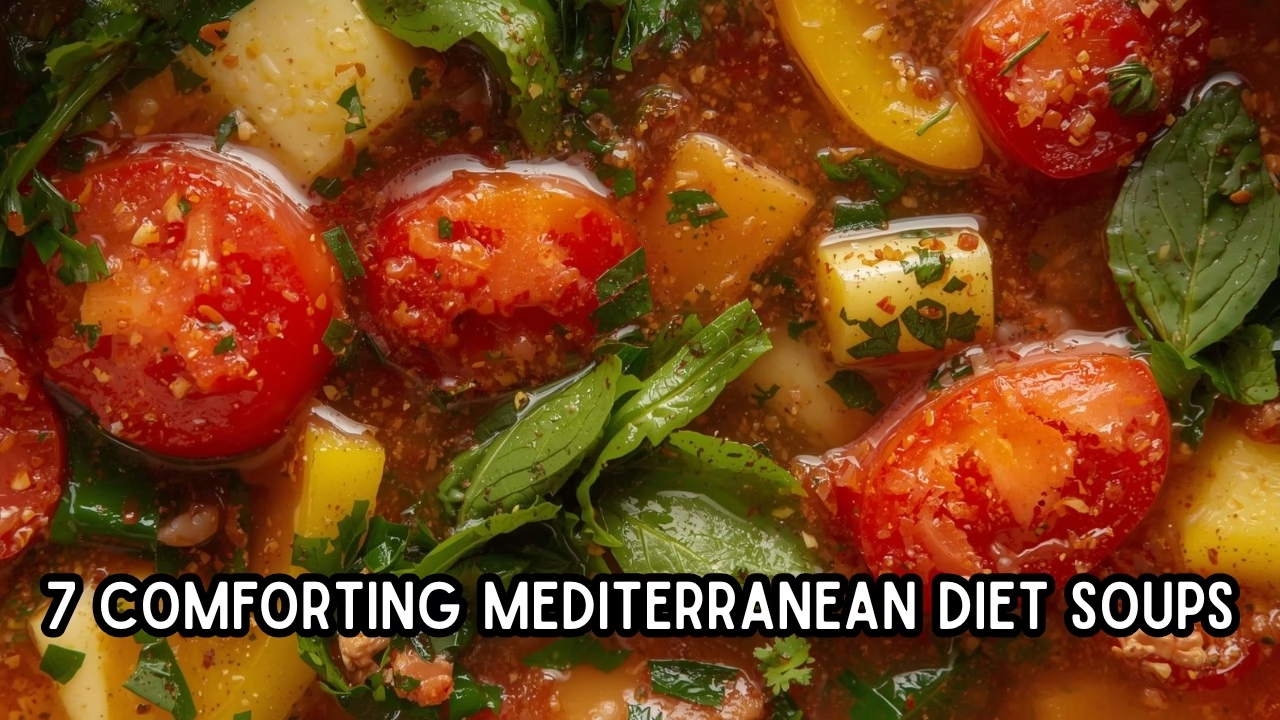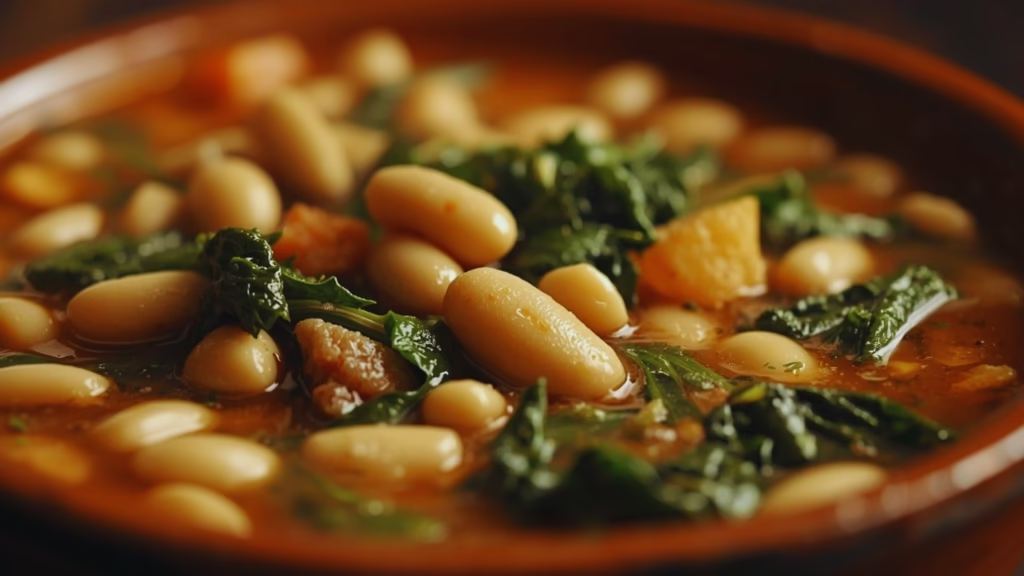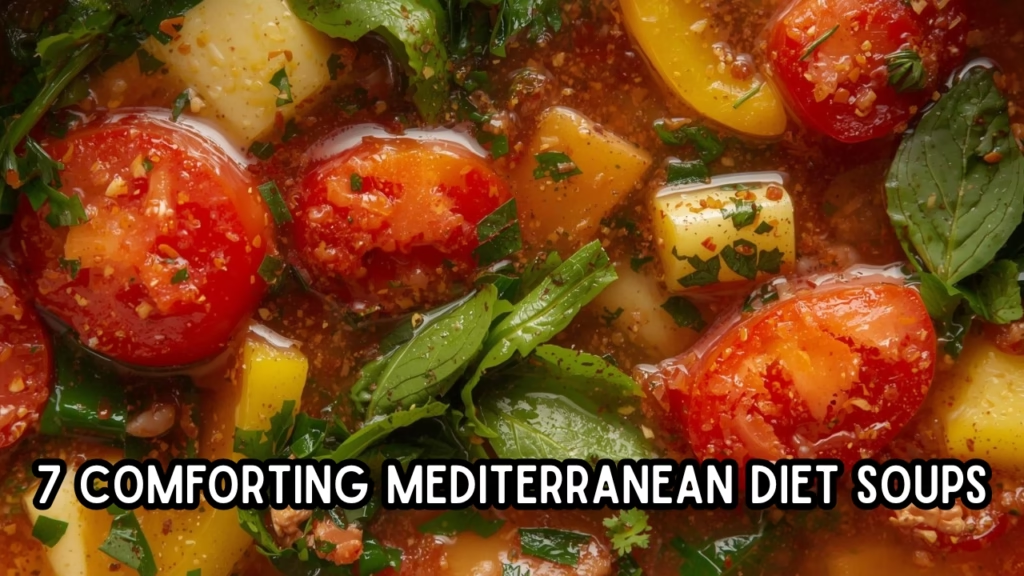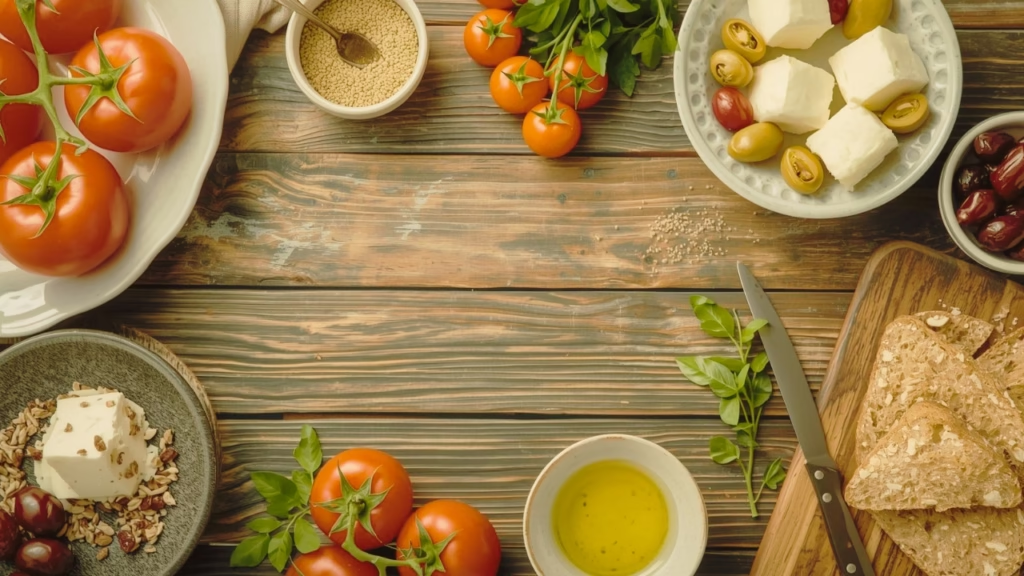Mediterranean diet soups represent a cornerstone of one of the world’s healthiest eating patterns, combining nutrient-dense ingredients with time-tested culinary techniques that have sustained populations around the Mediterranean Sea for thousands of years.
What defines a Mediterranean diet soup? These soups are characterized by their emphasis on plant-based ingredients, healthy fats from olive oil, lean proteins, and an abundance of vegetables, legumes, and whole grains. Unlike cream-based soups common in Western cuisine, Mediterranean soups derive their richness from the natural flavors and nutritional properties of whole foods.
This comprehensive guide explores seven fundamental Mediterranean soup recipes that exemplify the principles of this dietary pattern while remaining accessible to home cooks of all skill levels.

The Nutritional Foundation of Mediterranean Diet Soups
Core Ingredients and Their Health Benefits
Mediterranean diet soups made with simple healthy ingredients follow a consistent nutritional framework that distinguishes them from other soup traditions.
Primary components include:
Extra virgin olive oil: Serves as the primary cooking fat, providing monounsaturated fatty acids that support cardiovascular health. Unlike saturated fats found in butter, olive oil contains polyphenols and antioxidants that reduce inflammation throughout the body.
Legumes: Beans, lentils, and chickpeas form the protein foundation of many Mediterranean soups. These plant-based proteins offer complete nutrition when combined with whole grains, delivering essential amino acids, fiber, iron, and B vitamins.
Vegetables: Mediterranean soups incorporate both aromatic vegetables (onions, garlic, celery, carrots) and seasonal produce (tomatoes, zucchini, leafy greens, bell peppers). This variety ensures a broad spectrum of vitamins, minerals, and phytonutrients.
Herbs and spices: Rather than relying on excessive salt or artificial flavorings, Mediterranean cooking employs fresh and dried herbs (basil, oregano, rosemary, thyme, parsley) and warming spices (cumin, coriander) that contribute both flavor and antioxidant properties.
Whole grains: When grains appear in Mediterranean soups, they remain minimally processed—think farro, barley, bulgur, or whole wheat pasta rather than refined white rice or noodles.
The Science Behind Satiety
One distinguishing characteristic of Mediterranean diet soups is their ability to provide lasting satiety despite being relatively low in calories.
This occurs through several mechanisms:
Fiber content: Vegetables and legumes contribute significant dietary fiber, which slows gastric emptying and promotes feelings of fullness. A single bowl of white bean soup can provide 12-15 grams of fiber—nearly half the recommended daily intake.
Protein density: Legumes and lean proteins stimulate the release of satiety hormones like peptide YY and GLP-1, which signal fullness to the brain and reduce subsequent food intake.
Healthy fats: The olive oil used in Mediterranean soups provides essential fatty acids that slow digestion and contribute to meal satisfaction without the inflammatory effects of saturated fats.
Water content: The high liquid volume of soups increases stomach distension, triggering stretch receptors that communicate fullness to the central nervous system.
Research published in nutritional journals indicates that individuals who regularly consume bean-based soups experience better weight management and improved metabolic markers compared to those who consume cream-based or broth-only soups.
Recipe #1: Tuscan White Bean Soup with Dark Leafy Greens

Historical and Cultural Context
Tuscan white bean soup, known in Italy as “zuppa di fagioli,” exemplifies the peasant food tradition that characterizes much of Mediterranean cuisine. This soup developed as an economical way to combine affordable pantry staples into nutritionally complete meals.
Nutritional Profile and Health Benefits
White beans (cannellini or great northern varieties) provide approximately 15 grams of protein and 12 grams of fiber per cup when cooked. They’re particularly rich in:
- Folate: Essential for DNA synthesis and cell division
- Magnesium: Supports muscle and nerve function
- Iron: Necessary for oxygen transport in blood
- Resistant starch: Feeds beneficial gut bacteria and improves insulin sensitivity
Dark leafy greens like kale and spinach contribute vitamins A, C, and K, along with calcium, potassium, and numerous antioxidant compounds.
Ingredient List and Preparation Method
Essential ingredients:
- 2 cans (15 ounces each) white beans, divided
- 1 medium yellow onion, diced
- 2 medium carrots, diced
- 2 celery stalks, diced
- 4-5 garlic cloves, minced
- 4 cups low-sodium vegetable or chicken broth
- 3 cups fresh kale or spinach, roughly chopped
- 2-3 sprigs fresh rosemary or 1 teaspoon dried
- 3 tablespoons extra virgin olive oil
- 1 parmesan rind (optional but recommended)
- Sea salt and black pepper to taste
- Fresh lemon juice for finishing
Preparation technique:
- Create the aromatic base (soffritto): Heat olive oil in a large pot over medium heat. Add diced onion, carrots, and celery. Cook for 8-10 minutes until vegetables soften and onions become translucent. This slow cooking develops natural sugars and creates foundational flavors.
- Add garlic: Incorporate minced garlic and cook for 1-2 minutes until fragrant. Avoid browning garlic, as this creates bitter flavors.
- Create creamy texture: Drain one can of white beans, reserving the liquid. Blend these beans with their liquid until completely smooth. This creates a creamy base without dairy products.
- Build the soup: Add the blended bean mixture, remaining whole beans, broth, rosemary, and parmesan rind to the pot. Bring to a gentle boil, then reduce heat and simmer for 15-20 minutes to allow flavors to meld.
- Incorporate greens: Add chopped kale or spinach during the final 3-5 minutes of cooking. Leafy greens wilt quickly and retain more nutrients when added near the end.
- Finish properly: Remove parmesan rind and rosemary stems. Season with salt and pepper. Add a squeeze of fresh lemon juice to brighten flavors.
Educational Notes on Technique
Why blend some beans? This technique creates a creamy consistency without adding dairy or flour-based thickeners. The blended beans provide body while whole beans add textural interest and visual appeal.
The parmesan rind secret: Parmesan rinds contain concentrated umami compounds that infuse soups with deep, savory flavor. Save rinds in the freezer specifically for soup-making purposes.
Timing of greens: Adding delicate greens at the end preserves heat-sensitive vitamins like vitamin C and folate while maintaining vibrant color and pleasant texture.
Recipe #2: Mediterranean Vegetable Soup with Chickpeas
The Principle of Seasonal Adaptation
Mediterranean vegetable soup demonstrates a fundamental principle of Mediterranean eating: adapting recipes based on seasonal availability. This approach ensures peak nutritional content, optimal flavor, and economic efficiency.
Nutritional Composition
This soup exemplifies the Mediterranean diet’s emphasis on vegetable diversity. Consuming a variety of colorful vegetables ensures intake of different phytonutrients:
- Red/orange vegetables (tomatoes, peppers): Rich in lycopene and beta-carotene
- Green vegetables (zucchini, spinach): High in lutein and zeaxanthin
- Purple vegetables (eggplant): Contain anthocyanins with antioxidant properties
Chickpeas contribute plant-based protein (approximately 12 grams per cup) and provide a low glycemic index carbohydrate source that promotes stable blood sugar levels.
Ingredient Framework and Assembly
Core vegetables (use 6-8 cups total, mixed):
- 2 medium zucchini, diced
- 2 bell peppers (any color), chopped
- 1 small eggplant, cubed
- 3 medium tomatoes, diced (or one 14-ounce can)
- 1 large onion, diced
- 4 garlic cloves, minced
Supporting ingredients:
- 1 can (15 ounces) chickpeas, drained and rinsed
- 6 cups vegetable broth
- 3 tablespoons extra virgin olive oil
- 1 teaspoon dried oregano
- 1 teaspoon dried thyme
- 1 bay leaf
- Salt and black pepper
- Fresh basil and parsley for garnish
- Lemon wedges for serving
Cooking methodology:
- Establish flavor foundation: Sauté onions in olive oil over medium heat for 5-7 minutes until softened.
- Layer aromatics: Add minced garlic and cook for 1-2 minutes.
- Add vegetables strategically: Incorporate harder vegetables first (eggplant, peppers), cooking for 3-4 minutes before adding softer vegetables (zucchini, tomatoes). This ensures even cooking and prevents mushiness.
- Introduce liquid and seasonings: Pour in broth, add dried herbs and bay leaf. Bring to a boil, then reduce to a simmer.
- Simmer appropriately: Cook for 20-25 minutes until all vegetables reach desired tenderness.
- Final additions: Add chickpeas during the last 5 minutes to heat through. Remove bay leaf before serving.
- Enhance with fresh elements: Finish with torn fresh basil, chopped parsley, a drizzle of olive oil, and fresh lemon juice.
Understanding Cooking Times
Why do cooking times matter? Different vegetables have varying cell wall structures and water content. Eggplant and peppers have denser structures requiring longer cooking, while zucchini and tomatoes soften quickly. Staggering additions preserves textural integrity.
The role of acidity: Lemon juice added at the end provides brightness that balances the earthy flavors of vegetables and enhances overall taste perception without additional salt.
Recipe #3: Lentil Soup with Spinach and Lemon
Lentils: A Mediterranean Dietary Staple
Lentils have sustained Mediterranean populations for millennia, appearing in archaeological records dating back 10,000 years. Their nutritional density and quick cooking time made them invaluable in traditional diets.
Nutritional Analysis
A one-cup serving of cooked lentils provides:
- 18 grams of protein: Essential for tissue repair and immune function
- 16 grams of dietary fiber: Supports digestive health and cholesterol management
- 37% of daily iron needs: Particularly important for those following plant-based diets
- 90% of daily folate needs: Critical for cardiovascular health and fetal development
- Polyphenols: Antioxidant compounds that reduce oxidative stress
When combined with vitamin C-rich spinach and lemon juice, iron absorption from lentils increases significantly due to vitamin C’s role in converting non-heme iron to its more bioavailable form.
Complete Ingredient List
Primary components:
- 1½ cups dried green or brown lentils, rinsed
- 1 large onion, diced
- 2 carrots, diced
- 2 celery stalks, diced
- 4 garlic cloves, minced
- 6 cups vegetable broth
- 3 cups fresh spinach, roughly chopped
- 3 tablespoons extra virgin olive oil
- 1 teaspoon ground cumin
- 1 teaspoon ground coriander
- 1 bay leaf
- Juice of 1 large lemon
- Salt and black pepper
- Fresh dill for garnish (optional but traditional)
Detailed preparation:
- Prepare lentils: Rinse lentils thoroughly to remove any debris. Unlike beans, lentils require no pre-soaking.
- Build aromatic foundation: Heat olive oil in a large pot. Sauté onion, carrots, and celery for 8-10 minutes until vegetables begin to caramelize slightly.
- Incorporate aromatics and spices: Add garlic, cumin, and coriander. Cook for 1-2 minutes until fragrant. Toasting spices releases essential oils and intensifies flavor.
- Add lentils and liquid: Pour in rinsed lentils, broth, and bay leaf. Bring to a boil, then reduce to a gentle simmer.
- Cook to proper texture: Simmer for 25-30 minutes. Green and brown lentils should be tender but retain their shape. Red lentils break down and create a thicker consistency.
- Wilt greens: Add spinach during the final 3-4 minutes of cooking.
- Finish with acid: Remove from heat. Stir in lemon juice and season with salt and pepper. The lemon juice should be added at the end to preserve its bright, fresh flavor.
- Garnish appropriately: Top with fresh dill and an additional drizzle of olive oil if desired.
Scientific Principles at Work
Protein complementarity: While lentils provide substantial protein, they’re lower in methionine (an essential amino acid). When consumed with whole grains throughout the day, this creates complete protein profiles comparable to animal products.
The cumin-coriander combination: These spices don’t just add flavor—they contain compounds that aid digestion and have anti-inflammatory properties. Research suggests cumin may help regulate blood sugar levels.
Lemon’s multiple roles: Beyond enhancing iron absorption, the citric acid in lemon juice balances the earthy flavor of lentils and reduces the need for excessive salt.
Recipe #4: Chicken, Chickpea, and Kale Soup
Balancing Plant and Animal Proteins
This soup demonstrates the Mediterranean approach to meat: used as a flavor component and protein source rather than the primary focus. Traditional Mediterranean eating patterns include poultry 2-3 times per week, always accompanied by abundant vegetables.
Nutritional Synergy
Combining chicken with chickpeas provides:
- Complete amino acid profile: Chicken supplies all essential amino acids
- Increased fiber: Chickpeas contribute soluble and insoluble fiber
- Enhanced satiety: The protein-fiber combination promotes fullness
- Mineral diversity: Chicken provides selenium and zinc; chickpeas offer iron and magnesium
Kale contributes vitamins K, A, and C, plus calcium and powerful antioxidants called glucosinolates that support detoxification processes.
Ingredient Specifications
Main components:
- 1 pound boneless, skinless chicken breast, diced into ½-inch pieces
- 1 can (15 ounces) chickpeas, drained and rinsed
- 1 bunch kale (about 6 cups), stems removed and leaves chopped
- 1 large onion, diced
- 2 celery stalks, diced
- 4 garlic cloves, minced
- 1 can (14 ounces) fire-roasted tomatoes
- 1 cup quartered artichoke hearts (jarred or canned)
- 6 cups low-sodium chicken broth
- 3 tablespoons extra virgin olive oil
- 1 teaspoon Italian herb blend
- ½ teaspoon red pepper flakes (optional)
- Juice of 1 lemon
- Salt and black pepper
Systematic preparation:
- Sauté aromatics: Heat olive oil over medium heat. Add onion and celery, cooking until softened (about 6-7 minutes).
- Cook chicken: Add diced chicken, garlic, and Italian herbs. Cook, stirring occasionally, until chicken loses its pink color (approximately 5-6 minutes).
- Build soup base: Add fire-roasted tomatoes with their juices, artichoke hearts, and chicken broth. The fire-roasted tomatoes contribute smoky depth that enhances overall flavor complexity.
- Simmer appropriately: Bring to a boil, then reduce heat and simmer for 15 minutes to allow flavors to develop and chicken to cook through completely.
- Add remaining ingredients: Incorporate chickpeas and chopped kale. Simmer for an additional 5-7 minutes until kale wilts and becomes tender.
- Finish properly: Remove from heat and stir in fresh lemon juice. Season with salt and pepper to taste.
Educational Insights
Why dice chicken small? Smaller pieces cook faster and more evenly, reducing the risk of overcooking and toughness. They also distribute protein throughout the soup more effectively.
Fire-roasted tomatoes vs. regular: Fire-roasting caramelizes tomato sugars and creates complex flavors through the Maillard reaction. This adds depth without additional cooking time.
Kale preparation: Removing tough stems before chopping ensures tender texture. Kale stems can be saved for vegetable stock or composted.
Recipe #5: Tomato, White Bean, and Orzo Soup
Understanding Whole Grain Integration
This soup demonstrates how Mediterranean cuisine incorporates whole grains and pasta in balanced portions. Orzo, while not a whole grain, represents the Mediterranean tradition of using pasta as one component of a meal rather than the foundation.
Nutritional Composition
This soup provides:
- Complex carbohydrates: From orzo and beans for sustained energy
- Plant-based protein: White beans supply complete nutrition
- Lycopene: Tomatoes provide this powerful antioxidant, enhanced when cooked
- B vitamins: Enriched pasta contributes folate and other B vitamins
The combination creates a balanced macronutrient profile suitable for sustained energy and metabolic health.
Complete Ingredient List
Required ingredients:
- 1 cup orzo pasta (whole wheat preferred)
- 2 cans (15 ounces each) white beans, drained and rinsed
- 1 can (28 ounces) crushed tomatoes
- 1 large onion, diced
- 2 carrots, diced
- 4 garlic cloves, minced
- 6 cups vegetable broth
- 2 cups fresh spinach
- 3 tablespoons extra virgin olive oil
- 1 teaspoon dried Italian herbs
- ¼ teaspoon red pepper flakes
- Fresh basil leaves
- Grated parmesan for serving
- Salt and black pepper
Methodical preparation:
- Create flavor base: Sauté onion and carrot in olive oil over medium heat for 8-10 minutes until vegetables soften and begin to caramelize.
- Add aromatics: Incorporate garlic, Italian herbs, and red pepper flakes. Cook for 1-2 minutes.
- Add tomatoes and broth: Pour in crushed tomatoes and vegetable broth. Bring to a boil.
- Cook orzo: Add orzo directly to the soup. This technique allows the pasta to release starches that naturally thicken the broth. Cook according to package directions, typically 8-10 minutes.
- Incorporate beans and greens: Add white beans and spinach during the final 3-4 minutes of cooking.
- Season and serve: Adjust seasoning with salt and pepper. Garnish with torn fresh basil and grated parmesan.
Technical Considerations
Pasta absorption: Orzo continues absorbing liquid after cooking. For meal prep, consider cooking orzo separately and adding to individual portions when reheating.
Tomato acidity: The natural acidity in tomatoes can be balanced with a small pinch of sugar or by cooking longer to develop sweeter notes through caramelization.
Starch thickening: The starch released from orzo creates a silky texture. Avoid rinsing pasta before adding to soup, as this removes beneficial starches.
Recipe #6: Roasted Red Pepper and White Bean Soup (Pureed)
The Art of Creating Creamy Textures Without Dairy
This soup exemplifies how Mediterranean cooking achieves richness and creaminess through plant-based ingredients rather than dairy products. Beans, when pureed, create luxurious textures while contributing protein and fiber.
Nutritional Benefits of Roasted Peppers
Red bell peppers are exceptionally nutrient-dense:
- Vitamin C: One pepper provides 300% of daily needs
- Vitamin A: Essential for eye health and immune function
- Antioxidants: Including beta-carotene and lycopene
- Low calorie density: High volume with minimal calories
Roasting peppers concentrates their natural sugars and creates complex flavors through caramelization.
Ingredient Specifications
Primary ingredients:
- 4 large red bell peppers, roasted (or 2 cups jarred roasted peppers)
- 2 cans (15 ounces each) white beans, drained and rinsed
- 1 large onion, diced
- 4 garlic cloves, minced
- 4 cups vegetable broth
- 2 tablespoons extra virgin olive oil, plus more for finishing
- 1 teaspoon smoked paprika
- ½ teaspoon ground cumin
- Salt and black pepper
- Fresh basil for garnish
- Toasted pine nuts (optional)
Detailed preparation method:
- Roast peppers (if using fresh): Place whole peppers under a broiler or over a gas flame, turning occasionally until skin blackens completely (10-15 minutes). Transfer to a covered bowl for 10 minutes to steam. Remove skin, stems, and seeds.
- Build aromatic base: Sauté onion in olive oil over medium heat for 7-8 minutes until soft and translucent.
- Add garlic and spices: Incorporate garlic, smoked paprika, and cumin. Cook for 1-2 minutes until fragrant.
- Combine main ingredients: Add roasted peppers, white beans, and vegetable broth. Bring to a simmer and cook for 10-15 minutes to allow flavors to meld.
- Puree until smooth: Using an immersion blender or standard blender, puree soup until completely smooth and creamy. If using a standard blender, work in batches and allow soup to cool slightly before blending to prevent pressure buildup.
- Adjust consistency: If soup is too thick, add additional broth. Season with salt and pepper.
- Serve elegantly: Ladle into bowls. Drizzle with olive oil, garnish with fresh basil and toasted pine nuts if desired.
Understanding Puree Techniques
Immersion blender vs. standard blender: Immersion blenders offer convenience but may not achieve the same silky texture as high-powered standard blenders. Standard blenders create superior emulsification.
Temperature considerations: Hot liquids expand when blended. Fill blenders only halfway and hold the lid with a towel to prevent dangerous splashing.
Emulsification: Vigorous blending creates an emulsion between the water-based broth and oil-based compounds in beans, resulting in creamy mouthfeel without dairy.
Recipe #7: Traditional Minestrone Soup
Historical Context and Regional Variations
Minestrone represents one of Italy’s most iconic soups, with variations appearing across different regions based on local agricultural products. The name derives from “minestra” (soup) with the augmentative suffix “-one,” indicating a substantial, hearty soup.
Nutritional Completeness
Traditional minestrone exemplifies the Mediterranean principle of creating nutritionally complete meals from humble ingredients:
- Protein: From beans and pasta
- Complex carbohydrates: From vegetables and pasta
- Fiber: Abundant from vegetables and legumes
- Vitamins and minerals: From diverse vegetable selection
- Healthy fats: From olive oil
Comprehensive Ingredient List
Vegetable components:
- 1 large onion, diced
- 2 carrots, diced
- 2 celery stalks, diced
- 2 medium zucchini, diced
- 1 cup green beans, cut into 1-inch pieces
- 1 medium potato, diced
- 3 cups cabbage or chard, chopped
- 4 garlic cloves, minced
Remaining ingredients:
- 1 can (28 ounces) diced tomatoes
- 1 can (15 ounces) cannellini beans, drained and rinsed
- 1 cup small pasta (ditalini or elbow macaroni)
- 8 cups vegetable broth
- 3 tablespoons extra virgin olive oil
- 1 parmesan rind
- 2 bay leaves
- 1 teaspoon dried oregano
- 1 teaspoon dried basil
- Fresh parsley for garnish
- Grated parmesan for serving
- Salt and black pepper
Systematic cooking process:
- Create soffritto: Heat olive oil in a large pot. Add onion, carrots, and celery (the classic Italian soffritto). Cook for 8-10 minutes until vegetables soften and begin to develop color.
- Add garlic and herbs: Incorporate minced garlic, oregano, and basil. Cook for 1-2 minutes.
- Build soup base: Add diced tomatoes, vegetable broth, parmesan rind, and bay leaves. Bring to a boil.
- Add vegetables strategically: Add potato, green beans, and zucchini. These vegetables have similar cooking times. Simmer for 15 minutes.
- Incorporate leafy greens: Add cabbage or chard. Cook for 5-7 minutes until tender.
- Add beans and pasta: Incorporate cannellini beans and pasta. Cook according to pasta package directions, usually 8-10 minutes.
- Final adjustments: Remove parmesan rind and bay leaves. Season with salt and pepper. Garnish with fresh parsley and additional parmesan.
Educational Principles
Soffritto’s importance: This aromatic base appears throughout Mediterranean cooking. The slow cooking of onions, carrots, and celery in olive oil creates foundational flavors through caramelization and the Maillard reaction.
Vegetable flexibility: Minestrone traditionally uses whatever vegetables are seasonal and available. This adaptability makes it economical and sustainable.
The parmesan rind technique: As the rind simmers, it releases umami compounds and adds depth without artificial flavor enhancers. This technique appears throughout Italian cooking traditions.
Essential Principles for Mediterranean Soup Preparation
The Role of Quality Ingredients
Mediterranean cooking philosophy emphasizes ingredient quality over complexity. Simple preparations allow high-quality ingredients to shine.
Key considerations:
Extra virgin olive oil: Use genuine extra virgin olive oil, not blends or refined versions. Look for harvest dates, single-origin labels, and dark bottles that protect against light degradation.
Broth quality: Homemade broth provides superior flavor and allows sodium control. If using commercial broth, select low-sodium versions to manage salt intake.
Canned goods: When using canned tomatoes and beans, choose options without added sugars or excessive sodium. Organic options often have simpler ingredient lists.
Fresh herbs: While dried herbs work well during cooking, fresh herbs added at the end provide brighter flavors and more nutrients.
Understanding Flavor Development
Layering flavors: Mediterranean soups build flavor through sequential additions rather than combining everything at once.
The Maillard reaction: Allowing aromatics to caramelize slightly creates complex flavors through this chemical reaction between amino acids and reducing sugars.
Balancing tastes: Mediterranean soups balance five basic tastes—salt (from broth), sweet (from caramelized vegetables), bitter (from herbs), sour (from tomatoes or lemon), and umami (from parmesan, tomatoes, or mushrooms).
Finishing touches: The final additions of fresh herbs, lemon juice, and olive oil dramatically enhance flavor perception and should not be omitted.
Proper Storage and Food Safety
Cooling methodology: Cool soups rapidly by transferring to shallow containers. Place in refrigerator within two hours of cooking to prevent bacterial growth.
Storage duration: Refrigerate soups for up to 4-5 days. Most Mediterranean soups freeze successfully for up to 3 months.
Reheating considerations: Reheat soups to 165°F (74°C) to ensure food safety. Add additional broth if soups have thickened during storage.
Pasta in stored soups: Pasta continues absorbing liquid during storage. Consider storing pasta separately and adding to portions when reheating.
The Mediterranean Diet Context: Understanding the Bigger Picture
Beyond Individual Recipes
These seven soups exist within a broader dietary pattern characterized by:
Plant-forward eating: Vegetables, fruits, whole grains, legumes, and nuts form the foundation of meals.
Healthy fat emphasis: Olive oil replaces saturated fats from butter and animal sources.
Moderate protein portions: Fish consumed regularly (2-3 times weekly), poultry occasionally, red meat rarely.
Minimal processing: Foods remain close to their natural state rather than heavily refined or processed.
Social eating practices: Meals consumed slowly, ideally with others, promoting mindfulness and satisfaction.
Evidence-Based Health Outcomes
Extensive research documents the Mediterranean diet’s health benefits:
Cardiovascular health: Multiple studies, including the landmark PREDIMED trial, demonstrate reduced cardiovascular disease risk.
Metabolic health: Improved blood sugar control and reduced type 2 diabetes risk.
Cognitive function: Association with reduced cognitive decline and lower dementia risk.
Longevity: Mediterranean diet adherence correlates with increased lifespan and healthspan.
Weight management: Sustainable weight loss and maintenance without extreme restriction.
Practical Implementation
Start gradually: Begin by incorporating one Mediterranean soup weekly, gradually increasing frequency.
Focus on addition, not restriction: Emphasize adding beneficial foods rather than focusing on foods to avoid.
Embrace seasonal eating: Purchase produce at peak season for optimal nutrition, flavor, and cost-effectiveness.
Develop basic skills: Master fundamental techniques like soffritto, proper seasoning, and finishing touches.
Create routines: Establish regular soup-making days for efficient meal preparation.
Integrating Mediterranean Soups into Daily Life
Mediterranean diet soups made with simple healthy ingredients represent an accessible entry point into this well-researched dietary pattern. These seven soups demonstrate core principles—emphasis on vegetables and legumes, use of healthy fats, moderate portions of animal protein, and abundant herbs and spices for flavor without excessive sodium.
Key takeaways:
- Nutritional completeness: These soups provide balanced macronutrients, fiber, vitamins, and minerals in satisfying portions.
- Culinary accessibility: All recipes require basic cooking skills and widely available ingredients.
- Economic efficiency: Legume and vegetable-based soups offer substantial nutrition at minimal cost.
- Meal prep advantages: Most soups improve in flavor over time and store well, facilitating advance preparation.
- Flexibility: The provided recipes serve as frameworks adaptable to ingredient availability and personal preferences.
By understanding the nutritional science, culinary techniques, and cultural context behind these soups, home cooks can confidently prepare meals that support long-term health while providing genuine satisfaction and pleasure—the hallmark of sustainable dietary change.
Sources:
We carefully draw from trusted, evidence-backed sources to ensure our content’s accuracy and reliability.
Mediterranean soups use olive oil, vegetables, beans, herbs, and incorporate meat in small amounts alongside lots of dark leafy greens Mediterranean Living
Tuscan white bean soup uses white beans, kale/spinach, garlic, onion, and extra virgin olive oil Serious Eats
Mediterranean vegetable soup cooks quickly (30 minutes) using soft vegetables like zucchini, eggplant, peppers, tomatoes, and chickpeas Lader Love
30-minute Mediterranean chicken soup includes chicken breast, chickpeas, kale, fire-roasted tomatoes, artichokes, and garlic The Mediterranean dish
Blending beans or using day-old bread creates creamy texture without heavy cream Taste of home
Finishing soups with lemon juice, fresh herbs, and olive oil drizzle enhances flavor Cleveland Clinic

Hello! I’m Sangay Choda, the creator of Mediterranean Diet Choice.
I’m not a doctor or licensed dietitian — I’m a health enthusiast who has spent years exploring the Mediterranean lifestyle and its proven benefits for long-term wellness, balance, and longevity.
My interest in this way of living began with a simple goal: to understand how everyday food choices can protect our hearts, improve energy, and support a happier life. Over time, I have researched and curated information from trusted medical and nutritional authorities, such as:
Harvard T.H. Chan School of Public Health
Mayo Clinic
World Health Organization (WHO)
National Institutes of Health (NIH) and more
I take complex, research-backed insights from these sources and transform them into easy-to-read, practical guides that anyone can apply — especially those looking to live healthier without restrictive diets or complicated plans.
While I do not offer medical advice, every article on this website is created with care, transparency, and a commitment to evidence-based information. My mission is to help readers make informed choices for a balanced, Mediterranean-inspired lifestyle.
Disclaimer: The content on this site is for informational and educational purposes only and should not be used as a substitute for professional medical advice. Always consult a qualified healthcare provider before making significant health or dietary changes. For more details, please visit our Disclaimer page.
For additional information about this website and its purpose, visit our About page. You can also review our Terms & Conditions to understand your rights and responsibilities when using this site.
Thank you for visiting Mediterranean Diet Choice.If you have questions, suggestions, or wish to collaborate, feel free to reach out at contact@mdietchoice.com or contact us.



